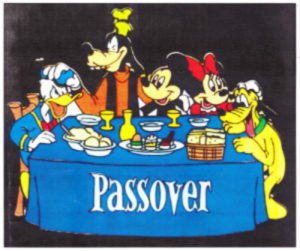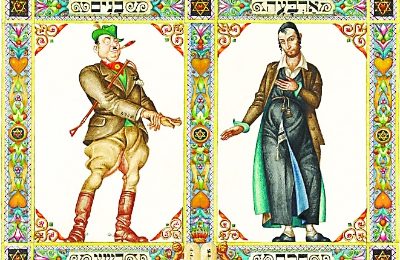 In keeping with the tradition we established two years ago, IJN staffers share some of their favorite moments and insights from this year’s seders. Let us know yours by posting a comment.
In keeping with the tradition we established two years ago, IJN staffers share some of their favorite moments and insights from this year’s seders. Let us know yours by posting a comment.
Animating the Exodus
The goal of the seder is to help each participant virtually experience the Jews’ exodus from Egypt on whatever level is understandable and appropriate. This year, with five grandchildren, ages 5 to 10, at our seder table, we used a Disney-themed Haggadah (see above), compiled by my brother Steve Hankin of Atlanta, to relate the Passover story to the kids — this along with the kids telling the story in their own words as they have learned it in school. Overall, it was fun and I think effective.
—Larry Hankin
L’Dor v’Dor
For me, the seder is when the family can get together for a beautiful meal and leave all of their differences at the front door. It’s all about family, sharing and, most important of all, a wonderful tradition that passes down from one generation to the next!
—Lori Aron
The obligation of remembering the Exodus
Based on an unexpected source cited by Maimonides to explain the Passover seder, Rabbi Joseph B. Soloveitchik observed that there are two types of remembering: immediate and continual. An immediate act of remembering is prosaic — to remember to put the milk back in the refrigerator, for example. The obligation to remember the Exodus is continual — all year round — analogous to the obligation to remember Shabbos all week long. Just as the remembrance of Shabbos culminates in the major ceremonies of its observance, so too the remembrance of the Exodus culminates in the major ceremonies of the Seder night.
—Rabbi Hillel Goldberg
The Four Sons
Each of the characteristics of the four sons can be interpreted positively or negatively. The wise son: Someone who knows a lot, has experienced life, such as a wise older person; on the negative side, someone who thinks he knows it all, a wise guy. The wicked son: the negatives are obvious, someone evil or bad; on the positive side, a rebellious person, someone who questions conventional wisdom to discover or create something new. The simple son: A modest, humble person, someone who doesn’t require high standards; on the negative side, a primitive, naïve person. And finally, the son who doesn’t know how to ask: On the positive side, he could be sensitive, more intuitive; for the negatives, not so educated and someone who could be easily manipulated.
The lesson: Characteristics are not black and white; everything’s got it good side and bad side, and there’s something to be learned from every person.
— Shana Goldberg (as told to)
What was your favorite moment of the seder? Share with us in a comment!













Hollow Words.
As we come up on the 2016 elections, it is important to reflect on a message from republicans from 2008 and 2012 regarding Obama. We told you so.
That being said, the fact that Iran doesn’t seem to agree with the White House about what the agreement is so far, seems to indicate to me that there isn’t an agreement. I mean, it’s pretty definitional that if two people disagree on what they have agreed on, then they haven’t agreed. They haven’t even agreed to disagree.
All this indicates to me is that this hypothetical agreement is merely for internal consumption in Iran, the US, and the EU.
Loved the reflections. Thank you Rocky Mountain Jew.